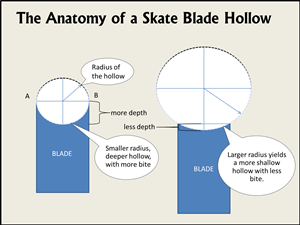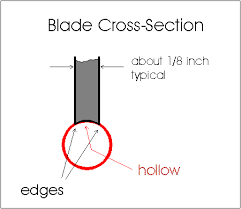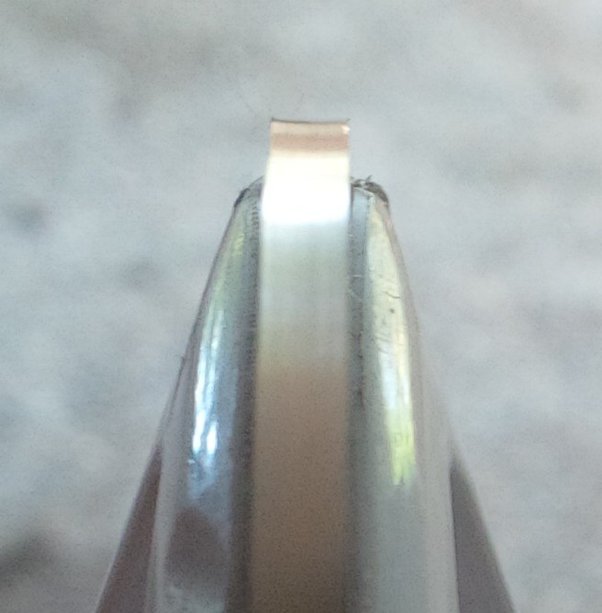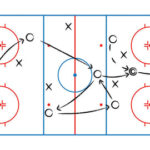Hockey skates are extremely sharp, with edges honed to a fine point. This precision allows for agility and speed on the ice.
Hockey skates are designed to provide players with maximum control and performance. The blades are meticulously sharpened to ensure they can cut into the ice effectively, allowing for quick turns, stops, and acceleration. Properly maintained skates can mean the difference between a good and great performance.
Regular sharpening is essential to maintain their effectiveness, as dull blades can hinder a player’s ability to maneuver. Understanding the importance of sharp skates and maintaining them can significantly enhance a player’s game. Whether you’re a beginner or a seasoned player, well-sharpened skates are crucial for optimal performance.

Credit: weekendwarriorshockey.com
Introduction To Hockey Skates
Hockey skates are crucial for the game of hockey. They allow players to glide, turn, and stop on the ice. The sharpness of the blades plays a vital role in performance.
Brief History
Hockey skates have a rich history dating back centuries. They began as simple blades strapped to shoes. Early skates were made from animal bones and leather straps. By the 19th century, metal blades were introduced. This allowed for better speed and control.
Evolution In Design
The design of hockey skates has evolved significantly. Modern skates feature high-quality steel blades. These blades are sharpened to precise angles. Skates now have boots made from synthetic materials. This offers better support and comfort.
Here is a brief comparison of old and modern skates:
| Feature | Old Skates | Modern Skates |
|---|---|---|
| Blade Material | Animal Bones | High-Quality Steel |
| Boot Material | Leather | Synthetic Materials |
| Support | Minimal | Enhanced |

Credit: weekendwarriorshockey.com
Anatomy Of A Hockey Skate
Understanding the anatomy of a hockey skate helps you appreciate its design. Hockey skates are engineered for speed, agility, and protection. They consist of two main components: the blade and the boot. Each part plays a crucial role in performance and comfort.
Blade Structure
The blade of a hockey skate is crafted from high-quality steel. The blade’s edge is honed to a sharp point, allowing for quick stops and sharp turns. The hollow part of the blade, known as the groove, enhances grip on the ice.
Blades have different profiles, influencing skating style. A deeper groove gives better grip but can slow you down. A shallower groove offers more speed but less control.
| Blade Profile | Advantages | Disadvantages |
|---|---|---|
| Deep Groove | Better Grip | Reduced Speed |
| Shallow Groove | More Speed | Less Control |
Boot Construction
The boot of a hockey skate offers support and protection. It is usually made from durable materials like synthetic leather and carbon fiber. This combination provides a lightweight yet sturdy structure.
Inside the boot, padding ensures comfort and reduces injury risk. The heel and ankle area are reinforced for added support. This design helps in maintaining balance and stability on the ice.
Laces and straps secure the boot, ensuring a snug fit. A well-fitted boot enhances control and agility, crucial for high-performance skating.
- Durable Materials: Synthetic leather, carbon fiber
- Reinforced Areas: Heel, ankle
- Secure Fit: Laces, straps
Importance Of Sharpness
Hockey skates need to be sharp. Sharp skates can make or break a game. The importance of sharpness in hockey skates is often underestimated. Skaters rely heavily on the sharpness of their blades. Sharp blades help in quick movements and precise control. Below, we explore why sharpness matters.
Impact On Performance
Sharp skates greatly impact performance. Skaters can glide smoothly and make quick turns. They can stop abruptly without losing balance. Sharp blades grip the ice better. This grip helps in faster acceleration. Players can execute complex maneuvers with ease. A skater with sharp blades can outmaneuver opponents.
Safety Considerations
Safety is crucial in hockey. Sharp skates contribute to safety on the ice. Dull blades can cause slips and falls. Sharp blades provide better stability. Players can avoid dangerous accidents. They can maintain their balance during high-speed plays. Sharp skates reduce the risk of injuries.
| Aspect | Impact |
|---|---|
| Performance | Better speed, control, and agility |
| Safety | Reduced slips and falls |
| Stability | Improved balance on ice |
- Sharp blades ensure quick movements.
- Dull blades increase risk of falls.
- Balanced skates improve overall game performance.

Credit: www.figureskatingetc.com
How Sharp Is Sharp Enough?
Hockey skates need to be sharp for optimal performance. But how sharp is sharp enough? Skates that are too dull or too sharp can affect your game. Finding the right balance is crucial for speed, control, and safety.
Optimal Sharpness Level
Most players prefer a medium sharpness level. This balances grip and glide on the ice. The sharpness is measured by the hollow radius of the blade.
| Hollow Radius | Sharpness Level |
|---|---|
| 3/8 inch | Very Sharp |
| 1/2 inch | Medium Sharp |
| 5/8 inch | Less Sharp |
Most players find the 1/2 inch radius ideal. It offers good control and speed. Goalies may prefer a less sharp blade for more stability.
Signs Of Dull Blades
Dull blades can make skating difficult. Here are some signs:
- Slipping during turns
- Difficulty stopping quickly
- Less control on the ice
Check for these signs regularly. If you notice any, it might be time to sharpen your skates.
Sharpening Techniques
Hockey skates need to be very sharp for maximum performance. The right sharpening techniques can make a big difference. Let’s explore two main methods: Manual Methods and Professional Services.
Manual Methods
Manual sharpening techniques involve using hand tools. These can be a sharpening stone or a file. Here’s a simple way to do it at home:
- Clean the blades thoroughly.
- Secure the skates in a vice.
- Use a sharpening stone to grind the edges.
- Check the sharpness by running a finger gently along the blade.
Manual methods offer more control. You can adjust the sharpness as needed. They are also cost-effective. But they require some skill and practice.
Professional Services
Professional sharpening services use specialized machines. These machines offer precise and consistent results. Here are the main steps:
| Step | Description |
|---|---|
| Step 1 | Inspect the blades for wear and tear. |
| Step 2 | Place the skates in a sharpening machine. |
| Step 3 | Set the desired hollow or radius. |
| Step 4 | Run the machine to sharpen the blades. |
Professional services ensure high-quality sharpening. They are fast and reliable. But they can be expensive and require a trip to a pro shop.
Maintaining Blade Sharpness
Maintaining the sharpness of hockey skates is crucial for peak performance. Sharp blades ensure better control, speed, and safety on the ice. Proper care and storage of your skates can extend their lifespan and keep them in top condition.
Routine Care
Regular maintenance is essential for keeping your hockey skates sharp. Follow these steps:
- Check the blades after each use for nicks and burrs.
- Wipe the blades with a dry cloth to remove moisture.
- Sharpen the blades every 15-20 hours of ice time.
- Use a blade cover when walking off the ice.
These steps can help in maintaining the sharpness and extending the life of your blades.
Storage Tips
Proper storage is vital for preserving the sharpness of your hockey skates. Consider these tips:
- Always dry the blades and boots thoroughly.
- Store skates in a cool, dry place.
- Use blade guards to protect the edges.
- Avoid leaving skates in your bag for long periods.
Following these storage tips will help keep your skates in excellent condition.
Expert Opinions
Understanding how sharp hockey skates should be can be tricky. Expert opinions provide valuable insights. Players and coaches share their experiences. This knowledge helps improve performance and safety.
Interviews With Players
Many players have strong opinions about skate sharpness. Here are some insights:
- Player A: “Sharp skates help me turn quickly.”
- Player B: “Dull skates make me slide uncontrollably.”
- Player C: “I sharpen my skates before every game.”
| Player | Preference |
|---|---|
| Player A | Very Sharp |
| Player B | Moderately Sharp |
| Player C | Regularly Sharpened |
Insights From Coaches
Coaches also offer valuable perspectives on skate sharpness:
- Coach X: “Sharp skates enhance agility and speed.”
- Coach Y: “Over-sharpening can cause balance issues.”
- Coach Z: “I recommend sharpening skates weekly.”
Coaches emphasize balance between sharpness and control. They suggest regular maintenance for optimal performance. This ensures skates are ready for action.
Common Myths
Hockey skates are often misunderstood. Many myths surround their sharpness. Let’s explore these myths to understand the reality.
Debunking Misconceptions
Many people believe hockey skates are as sharp as knives. This is not true. Skates are sharp, but they won’t cut you easily. The edges are designed for ice, not skin.
Another common belief is that sharper skates make you faster. This isn’t always correct. The sharpness needed depends on the player’s weight and style. Too sharp can reduce control, while too dull can slow you down.
Facts Vs. Fiction
Let’s set the record straight with some facts:
- Fact: Hockey skates are sharp enough to grip the ice.
- Fiction: Sharper skates are always better.
- Fact: Proper sharpening improves performance.
- Fiction: All players need the same sharpness.
The table below shows the differences between myths and facts:
| Myth | Fact |
|---|---|
| Hockey skates are as sharp as knives. | Skates are sharp for ice, not skin. |
| Sharper skates make you faster. | Sharpness needed varies by player. |
| All players need the same sharpness. | Sharpness depends on style and weight. |
Remember, skate sharpness is important but not everything. Understanding the right sharpness for your game can make a big difference.
Conclusion
Hockey skates need to be sharp for optimal performance. Regular maintenance ensures better control and speed on the ice. Dull blades can hinder your game. Proper sharpening techniques are essential. Always check your skates before hitting the rink. Stay ahead with well-maintained equipment and enjoy a smoother, more responsive experience.

